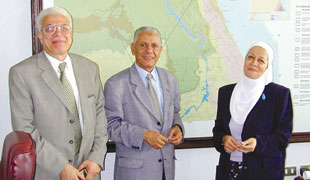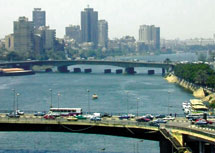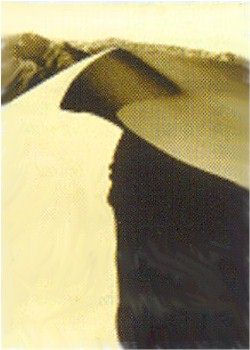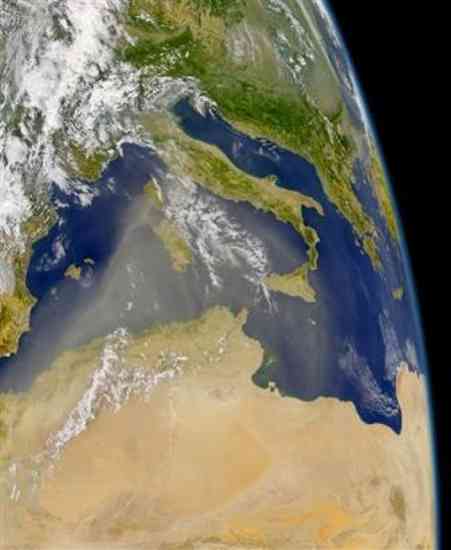Desert Odyssey
Windows in the MindAs a camel beareth labour, and heat, and hunger, and thirst, through deserts of sand, and fainteth not; - John Ruskin There are deserts in every life, and the desert must be depicted if we are to give a fair and complete idea of the country. - Andre Maurois by Kennedy Warne Grains of Sand
Lawrence of Arabia rode camels across them. Luke Skywalker honed his flying skills over them. Jesus Christ faced the devil in them. And Martin Buckley, sitting in a bath in London and poring over a soggy map, discovered he could go around the world through them: a circumnavigation by desert. Grains of Sand (Hutchinson, $49.95) is the account of Buckley's resulting two-year odyssey through the waterless places of the world - two bands of gold which ring our blue-green planet. His was no rich man's safari, no journalist's junket, but smell-of-an-oily-rag travel by jeep, camel, train, truck and foot that relied on local goodwill and luck. Sometimes dangerous, often unbearably slow, always physically demanding, the journey became for Buckley a chance to consider the human presence in these harsh places. Desert cultures are among the world's oldest and most untouched by the creep of globalisation. Yet as Buckley made his way from oasis to oasis, taking tea and sweetmeats in nomads' tents, sweating in the stifling heat of two-bit dives or firing a Kalashnikov with revellers at a wedding feast, he realised he was witnessing the gradual loss of whole tribes and traditional ways of life - a grim and lamentable fate. His discussions with the people he drove and lived with give Grains of Sand real backbone. The reader receives not only an excellent appreciation of the physical traits of the desert, but a sense of the hard life choices faced by desert dwellers. In many cases, the fundamental question is this: Is it better to remain poor but faithful to one's traditions, or seek the accoutrements of the wealthy West and suffer cultural impoverishment in the process?
Clouds of Dust
This true-color scene taken by the Sea-viewing Wide Field-of-view Sensor (SeaWiFS) Source: allhatnocattle.net 20 August 2004 See also:
Great Lakes beneath Their Feet:
|
 |
| Professor Aly Islam Metwally Aly and Dr Mohamed Fathy Ahmed Hassen, Chairman of the Egyptian Public Authority for Drainage Projects, join Dr Fatma Abdel Rahman Attia. |
Today the lakes lie staggered, tiered, and pooled far beneath the Sahara Desert and oasis settlements in Chad, Libya, Sudan, and Egypt. At strategic points, teams of scientists and engineers probe the underground chambers with 21st century tools, including nuclear-based methods. They are looking for answers that will help bring this old water to new communities, and sustain them for generations to come.
Egypt’s Dr Fatma Abdel Rahman Attia is at the forefront of this scientific detective work. She heads the Groundwater Sector in the Ministry of Water Resources and Irrigation, and has devoted a career to helping manage Egypt’s fragile water lifelines. From her Cairo office overlooking the Nile, she probes the past in order to see the future. “Egypt is the Nile,” she says. "But there are limits to what we can take from it. We need to encourage people to resettle in new communities away from population centers, and developing our groundwater is more important than ever. Water is an incentive for relocation."
Right now, Egypt’s fertile Nile valleys and delta — which account for less than a tenth of the total land area — are among the most crowded in the world. Population density there averages 1,500 inhabitants per square kilometre, and approaches 20,000 in teeming Cairo. Throughout the other 90% of Egypt, the numbers drop to only two people per square kilometre.
Wellsprings of Hope
Underlying more than two million square kilometres of land — about 20 times the area of North America’s Great Lakes — the Nubian aquifer is the world’s largest fossil water reserve. Experts estimate it holds up to 150,000 cubic kilometres of water, about 30 times more than the entire world uses today. Only a tiny fraction of Nubian water now is being tapped, while more ambitious plans take shape for supplying expanding cities and new settlements. In Libya, for example, thousands of deep wells have been drilled in the desert frontier. The ambitious US$ 25 billion “Great Man-Made River Project” pumps and pipes Nubian water thousands of kilometres to Tripoli and cities along the Mediterranean. In Egypt, wells drawing on shallower basins supply new and expanding communities in southwestern oases regions, including businesses that bottle and sell drinking water from the Nubian lakes.
Though the aquifer supports dreams of blooming deserts, unrestricted steps to exploit it could lead to nightmares if not taken carefully. The Nubian is considered a closed water system, with no known source of replenishment. Over time, more wells — like so many straws in a single jug — mean less water for everyone, and hasten the day when pumps run dry and deeper wells become too costly to drill.
"Fossil water is simply not renewable,” says Dr Attia. "But this doesn’t mean that fossil water should be left under the ground. We need to develop and manage it wisely."
Unlocking Age-old Secrets
While much is known about the Nubian, its multi-layered chambers hold as many secrets as the depths of oceans and seas. The system’s configurations and dynamics are complex, with many uncertainties complicating the scientific picture.
 |
| Egypt’s lifeline, the Nile River, in Cairo. |
"The Nubian extends beneath more than 60% of our country, and we’ve studied different parts over a long time," Dr Attia says. "We think it may hold hundreds of times more water than Egypt now gets from surface waters of the Nile. But as a finite and hard to reach resource, most of the aquifer cannot be tapped."
Egypt’s water policymakers face numerous strategic questions: How much of the Nubian can Egypt and its neighbours really afford to exploit? What are the recharge rates? Where and how deep should new wells be drilled that are able to sustain new settlements? Egyptian water authorities are spearheading national and regional projects to analyze the Nubian’s properties, characteristics, and processes. The data will refine topographical maps and models of the system. Co-operative channels include national and regional projects supported by the IAEA and partner organizations, such as the GEF, the financial coordinating body that helps sustainable development issues with trans-boundary dimensions.
The Desert’s Nuclear Detectives
Working with the IAEA, Egyptian scientists are engaged in one project initiated in 2001 to assess Nubian basins in the Bahariya and Farafra regions of Egypt’s western desert. The regions constitute about 150,000 square kilometres of sandy lowlands — about a tenth of Egypt’s total land area. Oases born decades ago are home to thousands of farming families, and wells have been drilled for irrigation and residential needs. Water is the bedrock of national policies calling for expanded development of the regions.
 To date, conventional hydrogeological studies have yielded important but limited information about the
Bahariya and Farafra aquifer systems. The analysts are using sensitive isotope techniques that enable them to analyse underground water molecules they cannot see but can
draw to the surface and sample. Because the isotopic description is within the hydrogen-oxygen water molecule itself, samples can be "fingerprinted" to understand the mix,
flow, origins, and recharge processes of deep aquifers. With support from GEF, Egypt now is preparing a proposal for a regional project whose studies will support improved
management of Nubian resources.
To date, conventional hydrogeological studies have yielded important but limited information about the
Bahariya and Farafra aquifer systems. The analysts are using sensitive isotope techniques that enable them to analyse underground water molecules they cannot see but can
draw to the surface and sample. Because the isotopic description is within the hydrogen-oxygen water molecule itself, samples can be "fingerprinted" to understand the mix,
flow, origins, and recharge processes of deep aquifers. With support from GEF, Egypt now is preparing a proposal for a regional project whose studies will support improved
management of Nubian resources.
In the Nubian, explains Professor Aly Islam Metwally Aly, Vice-Chairman of the Egyptian Atomic Energy Authority, more water samples need to be collected for chemical and isotope analyses from different parts of the system. "The plan calls for drilling five or six sampling wells at various intervals and depths. Based on what we learn, we will set up a more ambitious sampling scheme covering about 100 sites in the zones under study."
The pressures of development and population growth are formidable in Egypt. Conserving existing water resources while developing new ones beneath desert sands is the only way ahead. "Our sources of groundwater are vast, and they can be managed as a sustainable, even if not renewable, resource," says Egypt’s Dr Attia. "Water is life, the key to our future."
Source: www.iaea.org
![]()
Hot Summer in the US...

Source: www.nytimes.com
![]()
For pages on natural disasters - including lightning strikes, volcanoes, floods, global warming and more - as well as satellite photos and some great pictures of trees,
clicking the "Up" button immediately below takes you to the Table of Contents page for this Environment section.
 Animals
Animals Animation
Animation Art of Playing Cards
Art of Playing Cards Drugs
Drugs Education
Education Environment
Environment Flying
Flying History
History Humour
Humour Immigration
Immigration Info/Tech
Info/Tech Intellectual/Entertaining
Intellectual/Entertaining Lifestyles
Lifestyles Men
Men Money/Politics/Law
Money/Politics/Law New Jersey
New Jersey Odds and Oddities
Odds and Oddities Older & Under
Older & Under Photography
Photography Prisons
Prisons Relationships
Relationships Science
Science Social/Cultural
Social/Cultural Terrorism
Terrorism Wellington
Wellington Working
Working Zero Return Investment
Zero Return Investment by Martin Buckley
by Martin Buckley